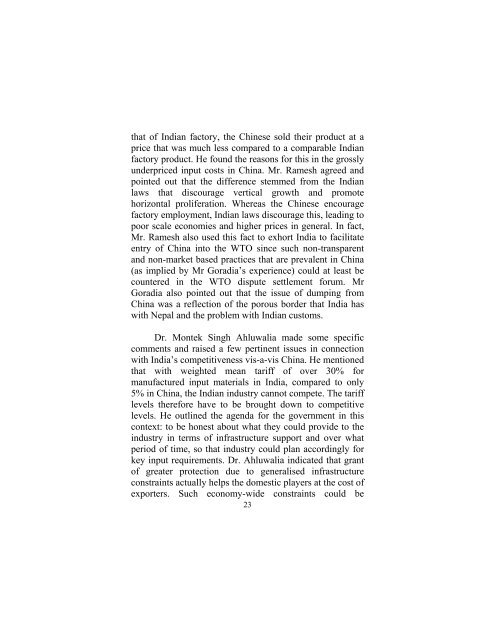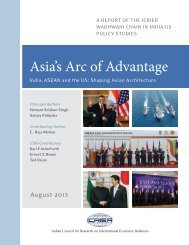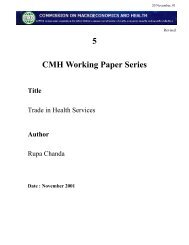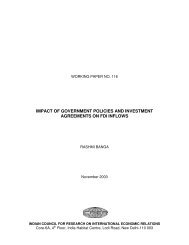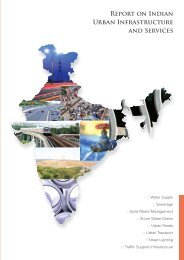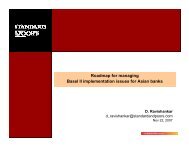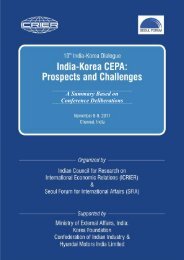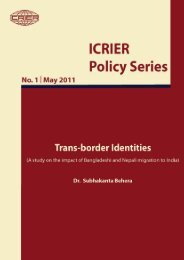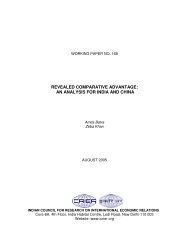china, wto and its impact on india - icrier
china, wto and its impact on india - icrier
china, wto and its impact on india - icrier
You also want an ePaper? Increase the reach of your titles
YUMPU automatically turns print PDFs into web optimized ePapers that Google loves.
that of Indian factory, the Chinese sold their product at a<br />
price that was much less compared to a comparable Indian<br />
factory product. He found the reas<strong>on</strong>s for this in the grossly<br />
underpriced input costs in China. Mr. Ramesh agreed <str<strong>on</strong>g>and</str<strong>on</strong>g><br />
pointed out that the difference stemmed from the Indian<br />
laws that discourage vertical growth <str<strong>on</strong>g>and</str<strong>on</strong>g> promote<br />
horiz<strong>on</strong>tal proliferati<strong>on</strong>. Whereas the Chinese encourage<br />
factory employment, Indian laws discourage this, leading to<br />
poor scale ec<strong>on</strong>omies <str<strong>on</strong>g>and</str<strong>on</strong>g> higher prices in general. In fact,<br />
Mr. Ramesh also used this fact to exhort India to facilitate<br />
entry of China into the WTO since such n<strong>on</strong>-transparent<br />
<str<strong>on</strong>g>and</str<strong>on</strong>g> n<strong>on</strong>-market based practices that are prevalent in China<br />
(as implied by Mr Goradia’s experience) could at least be<br />
countered in the WTO dispute settlement forum. Mr<br />
Goradia also pointed out that the issue of dumping from<br />
China was a reflecti<strong>on</strong> of the porous border that India has<br />
with Nepal <str<strong>on</strong>g>and</str<strong>on</strong>g> the problem with Indian customs.<br />
Dr. M<strong>on</strong>tek Singh Ahluwalia made some specific<br />
comments <str<strong>on</strong>g>and</str<strong>on</strong>g> raised a few pertinent issues in c<strong>on</strong>necti<strong>on</strong><br />
with India’s competitiveness vis-a-vis China. He menti<strong>on</strong>ed<br />
that with weighted mean tariff of over 30% for<br />
manufactured input materials in India, compared to <strong>on</strong>ly<br />
5% in China, the Indian industry cannot compete. The tariff<br />
levels therefore have to be brought down to competitive<br />
levels. He outlined the agenda for the government in this<br />
c<strong>on</strong>text: to be h<strong>on</strong>est about what they could provide to the<br />
industry in terms of infrastructure support <str<strong>on</strong>g>and</str<strong>on</strong>g> over what<br />
period of time, so that industry could plan accordingly for<br />
key input requirements. Dr. Ahluwalia indicated that grant<br />
of greater protecti<strong>on</strong> due to generalised infrastructure<br />
c<strong>on</strong>straints actually helps the domestic players at the cost of<br />
exporters. Such ec<strong>on</strong>omy-wide c<strong>on</strong>straints could be<br />
23


